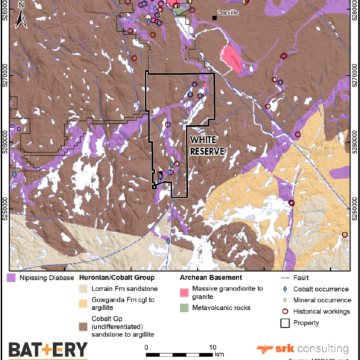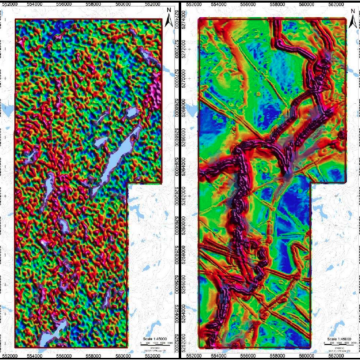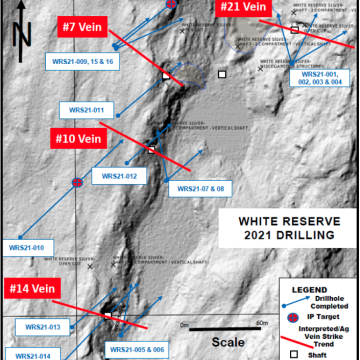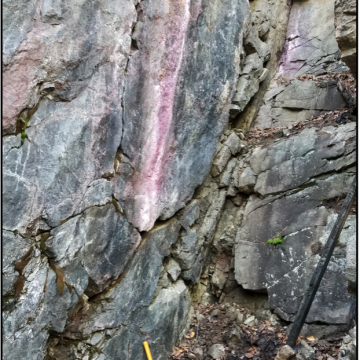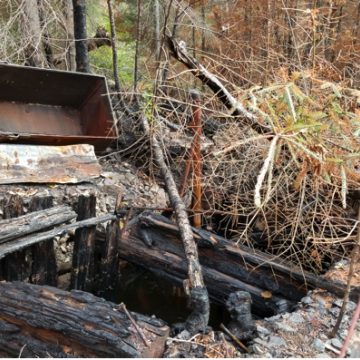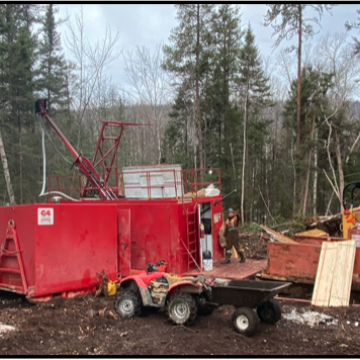White Reserve
Key Facts
Overview
BMR's White Reserve project is a high-grade Five Element vein type deposit within the Cobalt Embayment similar to the Cobalt Mining Camp. Much of the White Reserve property was burnt by a devasting forest fire during the summer of 2018.
The first recorded work on the White Reserve property in 1908 included an open cut from which 18,000 oz of silver was extracted on the 21 vein with an additional 1,773 oz silver and 452 lbs cobalt extracted intermittently from the 140 foot level of the main shaft between 1920 and 1940. Open cuts and shafts of varying depths were sunk on the number 7, 10, 14 and 21 veins, all of which produced significant historic cobalt and silver values. A sample taken from the 5 inch wide number 10 vein on the 140 foot level by the Resident Geologist from the Ontario Department of Mines in 1951 assayed 14.95% cobalt.
BMR conducted regional airborne magnetic and LiDAR surveys as well as prospecting traverses in 2016-18, a 3-D IP geophysical survey on the White Reserve project area in 2020 and a drilling program in March/ April of 2021. The drilling targeted all of the main vein systems and anomalies identified by the IP survey.
Historical Background
The White Reserve mine was operated from 1909 – about 1940. Early mine development included sinking of a shaft to 45m with two levels at 21m and 43m.
Four additional shafts and a total of 1105m of lateral underground workings were developed. Historically, 24 vein zones were located on the eastern and western rims of the diabase- enclosed valley. The more productive veins, #7, #10, #14, and #21 were explored with shafts and open cuts, the 3 former veins developed on the west side, and the latter, on the east.
White Reserve mine “reported historic” production amounted to 19,775 ounces of Silver & 452 pounds of Cobalt from the #21 Vein.
Geology & Mineralization
The White Reserve project comprises a 15 km long, north-trending belt of Proterozoic Nipissing Diabase that hosts seven Cobalt-Silver occurrences including the historic workings known as the White Reserve mine.
The property encompasses a linear north-northeast-trending zone of the Nipissing Diabase which intrudes older Huronian sediments, specifically the Gowganda and Lorain Formations. Regional north-south and northeast-trending faults transect the area. The Diabase cuts through the center of the property and hosts all of the Cobalt occurrences and historic mine sites.
Cobalt - Silver mineralization is generally confined to the diabase in veins that parallel the numerous faults and structures. Cobalt - Silver mineralization occurs as vein-filled fractures, ranging from hairline fractures to a maximum width of 0.08m. Vein selvages consist of Epidote-Hematite-altered zones.
The dominant sulphide minerals are Niccolite and Smaltite, with minor amounts of native Bismuth and Silver. Disseminated Cobalt Sulphides are hosted in a Granophyric phase of the Nipissing Diabase. Additionally, disseminated Cobalt-Silver mineralization was noted up to 1.5 meters on either side of vein fractures.
Current Exploration
To date, BMR has undertaken airborne magnetic and radiometric surveys flown in 2016 along with a LIDAR topography survey flown in 2018. The magnetic survey highlights the north-northeast trending diabase body and cross-cutting northwest-trending structures.
Prospecting by BMR was focused around the historic workings in 2018 yielding encouraging rock grab sampling of in-situ veins and mine dump material. Assay results included values from 0.29% to 3.90% Cobalt, from 0.16% to 0.64% Nickel and up to 5.09g/t Silver.
In 2019 a grid-based geophysical three-dimensional distributed induced polarization (“3D IP”) survey was completed. BMR compiled a 3D geological model of the historic workings and main vein structures to identify targets and design the drill program.
A 2021 winter drill program was carried out consisting of 17 diamond drill holes totaling 1,838m targeting the historic White Reserve mine workings. The drilling targeted both strike and vertical extensions of the main veins and two high chargeability induced polarization geophysical targets.
The four main east-west striking Quartz-Carbonate-Silver-Cobalt vein structures were drill tested. Several of the holes were also planned to test a north-south high chargeability 3D IP geophysical anomaly located just west of the old mine workings in the Nipissing Diabase. Significant downhole core intercepts include;
- Drillholes WRS21-001 to 004: Targeted northernmost #21 Vein: Best result:
- 28.70g/t Silver over 0.50m from 34.25m (Drillhole WRS21001)
- Drillholes WRS21-007,008 & 012: Targeted the #10 Vein in the centre of the old mining area: Best result:
- 0.25% Cobalt over 0.50m from 61.00m (Drillhole WRS21007)
- Drillholes WRS21-005, 006, 013, 014: Targeted the southernmost #14 Vein: Best result:
- 1.14% Cobalt and 0.71% Nickel over 0.50m from 48.25m (Drillhole WRS21014)
- Drillholes WRS21-009,011, 015 & 016: Targeted the #7 Vein as well as the coincident North - South striking high amplitude IP Chargeability anomaly: Best results:
- 0.54% Cobalt and 8.33g/t Silver over 0.50m from 55.75m (Drillhole WRS21009)
- 0.19% Cobalt over 0.50m from 75.00m (Drillhole WRS21015)
- 175.00g/t Silver over 0.60m from 107.70m (Drillhole WRS21016)
Technical Report
February 5, 2021: Technical Report on Cobalt Exploration Assets in Canada prepared for Battery Mineral Resource Corp. prepared by SRK Consulting (Canada) Inc.

